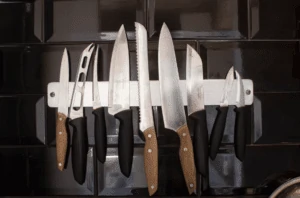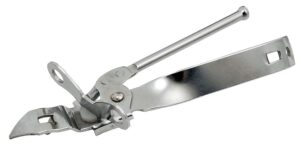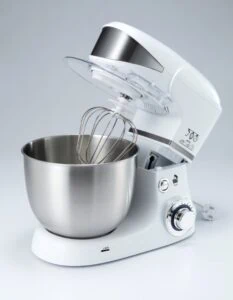You would celebrate if you could cut your grocery bill in half, right? But, besides the obvious savings, these tips can help turn your kitchen into an enjoyable space, not a reminder of how you can’t seem to keep up with demand or find an item when you need it.
A space that, no matter how basic or small, can be a haven and springboard to affordable stress-free meals and snacks. This article is about your ability to redirect money and time to other important things like family vacations, instead of spending so much money on grocery spending.
Note: Grocery bills are works in progress. A few tricks you end up actually using are going to be the tricks that work for you so you can save a lot.
Here’s a list of 19 tips to cut your grocery bill in half:
1. Know the how and why to cut your grocery bill in half
You can’t cut your bill in half if you don’t take the time to examine your current grocery shopping expenses. Go easy on yourself! You didn’t get here overnight, so changing course is going to take time.
First, review the previous two or three months of expenditures for groceries, online shopping, carry-out, and restaurants. If you don’t have receipts, think back as best you can.
Second, start taking notes on the rest of these steps and how you plan to apply them to your real, day-to-day life.
For example, how will you create additional storage in your already itty-bitty home? Maybe you could get rid of some kitchen tools that you don’t use in order to make room for a bulk sack of potatoes. Or maybe it’s worth it to your grocery budget to invest in a hanging veggie rack.
2. Get buy-in
Getting buy-in for yourself and family members, if needed, helps make the following tips doable. Buy-in is easier to get when approached like a game, not a chore. A game everybody wins.
3. Inventory
Take an inventory of your refrigerator, pantry, cabinets, and freezer. Empty contents onto a table or countertop.
Depending on your personality – Type A, Type B, Type DU (disastrously unorganized) – use a plain sheet of paper or type into a spreadsheet.
Whatever works for you is what works. Get in the habit of updating lists each time items are added or removed. Track expiration dates by marking containers so you know what should be used first.
Notes on inventorying before grocery shopping
Now, about those expiration dates. Since every item is required to have one, they do. But that doesn’t mean that an unopened and properly stored jar of peaches is bad as soon as the date marked on it says so. Give your items a little grace and let them stick around a few weeks or even months past the expiration date — if you’ve been storing them correctly (in a cool, dark, dry place and in a sealed, airtight container for example).
4. Create additional storage
Perhaps you could convert part of a closet or add shelving if needed. This is also a good time to clean and organize. Again, these upfront efforts will save more money going forward.
5. Meal planning
Here’s the buy-in part, big-time. Make sure you and your family will actually eat what is planned. An inexpensive dinner that no one wants is a waste of money.
While you plan, include favorites, comfort foods, treats, as well as healthy, new recipes.
Be realistic. Meal planning is constant rotation and evolution.
How to be serious about meal planning
Remember that planning your meals ahead might mean being open to change, based on how you and your family feel and on the latest leftovers you have from the last meals. For example, maybe your leftover lentil cake from yesterday changes tomorrow’s spaghetti plans: whiz up those lentils in the blender with some fresh herbs and roasted veggies, an egg, and breadcrumbs to make a vegan-friendly, gluten free, and cheaper alternative to meatballs for spaghetti night.
Save even more: Look for ingredient overlaps. Learn about portion sizes.
6. Avoid packaged/prepared meals
Sure, they’re convenient, but store-brand goods like foods that come in packages, in the form of prepped meals, or processed foods are expensive and come with extra, wasteful packaging. Plus, whole foods are usually a lot healthier.
Saving money buy buying bulk
If you’re a dairy-free milk drinker, a good way to save extra money on those expensive nut and seed milk is to make your own. Go to the bulk section and look for nut sales. My local grocery store used to hold a sale on either almonds or walnuts about once per week to get rid of old batches for fresh shipments.
Well, whichever nut is on sale is your nut milk friend for the next few weeks! Buy up whatever fits in your budget, soak in water overnight, and blend and filter the next morning for your own easy, less money and big savings milk.
7. Make a list, check it twice
Here’s where your refrigerator, pantry, and freezer inventories payoff. Shop from your own supplies first and try out freezer cooking. Look at your lists so you know what’s on hand to avoid unnecessary grocery trip spending and ensure you’re within your grocery budget.
8. List order should mirror store aisle order
Write your grocery shopping list in the same order you walk through grocery stores. When you’re organized before you even leave your house, you will save time and, importantly, help you save money by sticking to your food budget.
9. Shop once a week
Shopping once a week is a no-brainer way to cut out costly, grocery budget-busting impulse buys. Subsequent weekly grocery trips should take previous expenditures into account.
This “lid” on spending targets helps you stick to your meal plan. And, yes, approach this like a game, not a chore, to encourage a positive and proactive approach to shopping trips.
10. Don’t shop hungry
Sounds like a cliché, but this one is true. Stick to your list. Shopping hungry means impulse purchases.
11. Don’t shop distracted
Concentration is key. Caveat: If you must take children or an elderly parent along, cut yourself some slack. Perfection is not possible, especially in a grocery store.
12. Clip coupons
Coupon clipping is an industry unto itself. Should you go decide to use your time reading and clipping coupons, do this only if you will consume the items.
Find printable coupons through mobile apps and online, and compare coupons between different stores to find the best good price before you plan your shopping trip.
Other coupon clipping ideas
If couponing is not your thing, at least not initially, grab store circulars – they’re usually stacked by the front door. Circulars are printed maps to weekly local grocery store savings and are similar to printable coupons. Look for opportunities to enroll in rewards cards and debit cards. These are other great ways to make a big difference in your savings.
You might even find great deals for a great selection of luxury items like sour cream and other dairy products, bakery items, and non-grocery items like toilet paper, paper towels, garden growing things, and seasonal items like watermelons in the summer.
13. Shop store sales
One of the easiest ways to save is on sales. Who doesn’t love a sale? Before you buy at sale prices, however, compare the item’s regular price or the unit prices listed on the price tab.
Get familiar with the sale routines of one grocery store so you can hit the sale spot on. After a few trips with this on your radar, you’ll know when to stock up on what.
Practice with sale prices
Cut your grocery bill by only buying what’s on sale. Yes, this takes practice. Fortunately, store employees will tell you about weekly sales, if asked. It’s all about customer satisfaction.
14. Buy in bulk
Bulk buying is essential to cutting your bill so you can start saving money, but only if you can use the item in a practical amount of time and store it conveniently.
Note: Having to fashion a bulk package of 100 paper towel rolls as a coffee table is not wise or convenient.
15. Meatless meals help in saving money and they’re nutritious
Start off with one or two meatless dinners per week. Breakfast for dinner? Sure! Eggs and legumes are less expensive than meat.
A meatless idea for saving more money
Tofu, if you haven’t already, is worth a try as a replacement for cheese, ground beef, eggs, or as a gluten free substitute for gluten meats. Bring home affordable and filling nutrient-dense meatless options.
Here’s one of our favorite tofu recipes: How To Roast Tofu
16. Substitute ingredients
Learn how to substitute and be open-minded regarding new entrees and ingredient combinations. Cook from scratch with items you already have in stock.
For example, make your own salad dressing and seasonings from your own herbs that you’ve bought in bulk or use fresh herbs from a community garden.
17. Make big batches
Carve out a cooking day or evening. Take advantage of a snow day, for example. Double and triple batches of pasta sauce, soups, etc. You’ll thank yourself later when meal prep time is slashed, and carry-out spending doesn’t happen.
18. Leftovers are your friend
Invest in reusable storage containers and sealable bags. Mix and match leftovers in the following days or freeze for later.
The average family doesn’t eat everything set before them, and what’s still left in the pot could be put to use tomorrow.
19. Freeze scraps
Keep a bag or container in your freezer and add to it as you cook. Example: Don’t throw out broccoli stems; freeze them for later, chopped up or blended into soups and sauces.
Using freezer cooking to save extra money
Edible scraps add nutrition, fill out serving sizes, and save extra money and stretch more food. Some of my favorite scraps to freeze are root vegetable peels, carrot tops, wilted celery sticks, and onion skins. You can dump all of these into a sealable container or bag and keep them in the freezer for several months until you’re ready to make a hearty soup and want to whip up your own vegetable broth. You can also do the same with unwanted meat cuttings and bones if you buy meat: save the pieces in an air-tight container in the freezer for up to six months and boil them in water and your own herbs to make a delicious, completely free and homemade broth for a sick day or as a base for the stew.
Read about safe food handling here.
Some extra notes
During college, when I really got serious about grocery budgeting, I learned about unit price versus full price when I was hunting for the best prices. I found that most price labels on the shelf below each item lists a bolded price for the item, and below lists a unit price that breaks that overall price down to how much the item costs per unit.
A unit might be one pound in a 5-pound bag of oranges, or one can in a 12-pack of tea.
Look at the unit when you’re comparing product brands to decide which brand sells the product at the best overall price. For example, you might be able to buy a 5-pound bag of oranges for $10, or you could buy from the bulk section and pay $1.50 for a 1-pound orange. It’s certainly a better choice, in this case, to pick your own oranges and fill your own bag, because once you’ve filled 5-pounds worth, you’ve spent just $7.50 for the same amount as the pre-filled bag — that’s $2.50 cheaper for your effort, and you got to choose the oranges too!
Conclusion
These tips are shopping habits that are a real step toward cutting your grocery bill in half. You may end up using all of them, or only a couple.
Take your time to develop a customized system that transforms shopping for groceries and your kitchen into a less-stressed, more affordable space!
Do you have any follow up comments on how you’ve found a great way to keep your grocery expenses down? Leave us a note!
References
- Want to cut your grocery bill in half? Take these 3 steps (2/15/17)
- 12 Secrets to Spending Less at the Grocery Store (9/3/19)
- Here’s the exact 7-step system I used to cut my grocery bill in half and save money on food (9/9/19)
- How to Make a Grocery Budget That’ll Actually Work for You (5/18/20)
- These Pantry Staples Will Save You Money (12/2/19)











